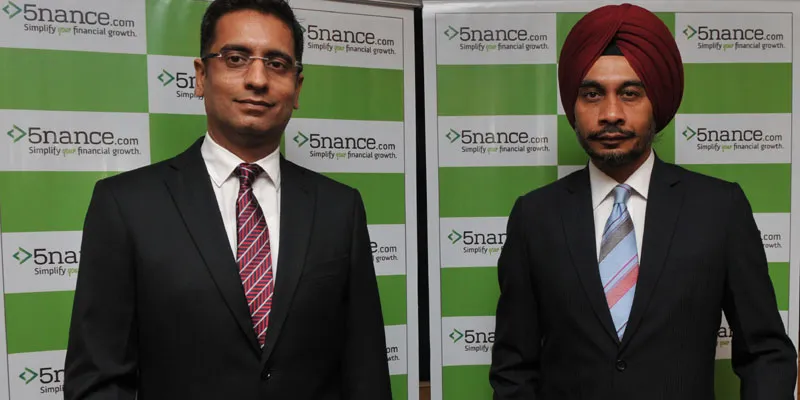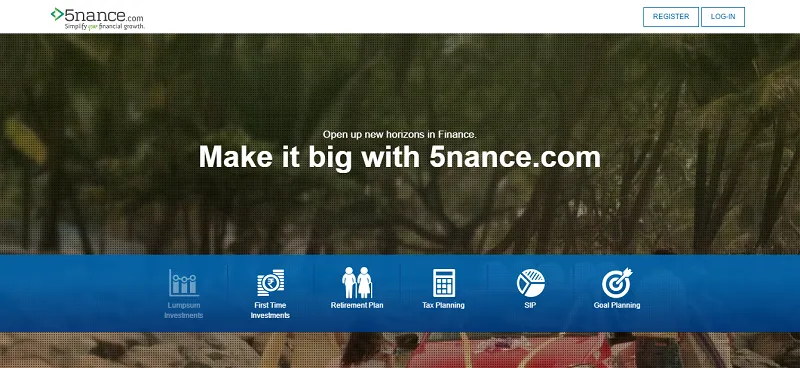Why this duo is helping the common man to grow his money
Dinesh Rohira and Ajay Arjit Singh have been best friends for the last 15 years. The pair ended up working together at Hewlett-Packard. However, the duo always wanted to startup their own venture.
While working on a project with Reliance money, Dinesh saw a huge gap in the financial sector. Further, he noticed that financial services in the industry were working in silos with no integration or communication with the other.
The duo conducted surveys across cities, which threw up interesting information on customer behaviour. One such nugget was on how users opt for online financial management, thanks to the comfort level it offered.

Ajay says,
A lot of individuals are clueless today on what to do with their finances. There is also a lack of an entity, which can tie them financially. Although the private and public banks are trying, their technology is not really filling the gap.
Thus 5nance.com, a financial management platform, went live in November 2015.
A platform for you and me
Recording a volume of more than 8,000 registered users in just six months, 5nance.com aims to be a one-stop platform for all financial needs of a common man.
Being a data-driven model, the platform offers aggregation of financial products, advisory with analytics over an integrated interface for free. According to Ajay, Co-founder of 5nance.com, the biggest challenge for the team was to simplify the platform, ensuring not to overwhelm the user.
A customer has to register on the website with their credentials such as name, e-mail ID, and their phone number. A password is then generated for the users to log in.
Once the customer logs in, some basic information (about his salary, savings etc.) is taken to assess the consumer’s risk appetite. Customers are also asked about their goals, such as child’s college fees or retirement planning, they’d like to achieve over a certain course of time.
The system shows the customers an array of offerings, structured from short-term to long-term finance planning, across products like mutual funds, corporate fixed deposits, debentures as well as loans.
Functioning in a KYC-regulated environment, the system automates the checks and completes the verifications when the user buys any product. In case a customer is not registered, the platform gets the KYC done for users at their doorstep.
While making payments, Ajay tells us that the payments are made directly between the two entities.
The analytics
Once a purchase has been successfully made, the metrics are reassessed and the user’s profile gets automatically updated. As the user makes more investments in newer funds, their goals, risk appetite, and overview of their finances also gets automatically updated.
Ajay tells us that there is an additional feature of integrating with people’s personal finances. Through permission, the platform picks up their online statements from their bank accounts, having read only credentials. If the user isn’t comfortable with sharing their credentials, they can also upload their statements onto the platform. This further helps to make the platform more insightful for the user.
The founders say,
The customers have the right to exit (from an investment) whenever they deem right. We even handhold and guide the customer to tell them the right time to exit a fund. Because we believe that one doesn’t make money when investing, but rather when they exit. So we have a complete track of your investment, making us not just an aggregation tool by rather a life cycle management entity.
Getting almost 20,000 users on a monthly basis, the average investment on the platform ranges from Rs 40,000 to Rs 2 lakhs per annum. The firm claims the number of visitors to be growing at 50 per cent month-on-month, with 62 per cent of their customers making repeat transactions.
5nance.com has raised more than three million in angel round and pre-Series A funding from angel investors and global venture fund Aspire Emerging Fund in July 2015. The firm also has a call center to assist users with the platform. However, the executives don’t consult customers on their investments.
The firm generates its revenue through charging a standard commission on every sale made, which is declared to the customer at the time of purchase. The commissions range depending on the product with mutual funds fetching one per cent upfront along with certain amounts payable annually. Targeting higher revenues, the firm plans to break even by 2018.

The future
In the future, the firm plans to look at higher salary segments of $1,00,000, adding paid personal advisory to the platform. With regulations opening up, and allowing entities to sell insurance with mutual funds (on the same platform), the firm plans to introduce newer product line of insurances and equity (including commodity and derivatives) to their existing offerings.
The platform also plans to target the bottom rung for investments, working to create specialised products for the rural sector with high reliability. Ajay says
Our platform stands for neutrality and user alignment. Our motto is not to be selling a particular financial product to our users, but to help them in order to foster our engagement with them for the coming years.
The market
Financial inclusion is a major landscape for the financial segment in India, with 60 per cent of the Indians being unbanked and 90 per cent of small businesses having no links to formal financial institutions. These individuals will be the next big target audience for companies who are trying hard to crack this market.
Over the past two to three years, the ecosystem has given rise to multiple money trackers like Money View, Walnut, Gullak and MyUniverse, with bigger banks being a part of the competition. The US has more than 49 per cent penetration when it comes to investment subscription (amongst its population), with the number being one per cent less for India.
A lot of the market is still offline with the common man investing in things like gold rather than banking products. In such scenarios, the biggest target for wealth management startups is to crack the mindset of the user, giving them the required confidence to make the investments.











